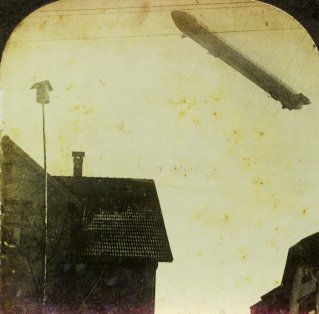War Zeppelins
Today, an old story about the danger of success. The University of Houston's College of Engineering presents this series about the machines that make our civilization run, and the people whose ingenuity created them.
Surely no activity exposes the unpredictibility of technology quite the way war does. For in war we try, again and again, to predict what a new technology -- the latest secret weapon -- will do in the near short term. We're almost always wrong.
The grandest and most dramatic machine of 1914 was surely the great airship. Those new engines of Count Zeppelin's fertile mind were stunning by any measure. Large as an ocean ship and four times as fast, they struck a chord in our hearts.
Then the guns of August, 1914! When WW-I began, Germany converted airships to bombers. Two Zeppelins reached Yarmouth in January, 1915. They damaged the town square, killed four people and wrecked some small buildings. The next month Germany tried again and lost two Zeppelins in a storm over Denmark.
It wasn't until Sept. 8, 1915, that Germany had its new bomber tactics under control. That night, four dirigibles rose up over the North Sea and made for London. Their prime target was, of all things, the Bank of England. The raid did great damage to civilian property and left 109 casualties in its wake.
Official English reports made light of the damage. But a German spy got hold of a secret report. It said the airships flew too high for English planes to reach or for searchlights to hold them. The damage had been far greater than they'd let on.
Germany was delighted. They didn't see that there was much more to it. They poured resources into airships and expanded tactics. For example, they invented an observer capsule they could lower thousands of feet while the airship lurked in cloud cover.
That was a nasty assignment. One observer was dashed against a cliff. Another was jettisoned when the dirigible suffered a gas leak and a stuck winch. They cut the cable just after the sinking ship had lowered the capsule until it struck earth.
The observer tumbled free and spent the next two months dodging the English, living in barns, stealing food. He actually breathed a sigh of relief when he was finally caught.
So, as Germany was fueled by the illusion of success, better planes finally reached dirigible altitudes. Defense technologies improved faster than attack technologies. Germany paid a terrible price as she kept flinging ill-fated dirigibles at England.
Those Zeppelins foreshadowed the horror and futility of bombing to come. They did more damage than history books tell. But, like the Battle of Britain in 1941, or the bombing of Hanoi in the '70s, they awoke a terrible resolve in the enemy below.
In the end, Germany failed. And her failure was cast, right away, in that deceptive success over London -- on Sept. 8, 1915.
I'm John Lienhard, at the University of Houston, where we're interested in the way inventive minds work.
(Theme music)
Cross, W., Zeppelins of World War I. New York: Paragon House, 1991.

Image courtesy of Sims McCutchan
Stereopticon photo of a WW-I vintage Zeppelin

Image courtesy of Sims McCutchan
Stereopticon image of a WW-1 dirigible passing over a German town